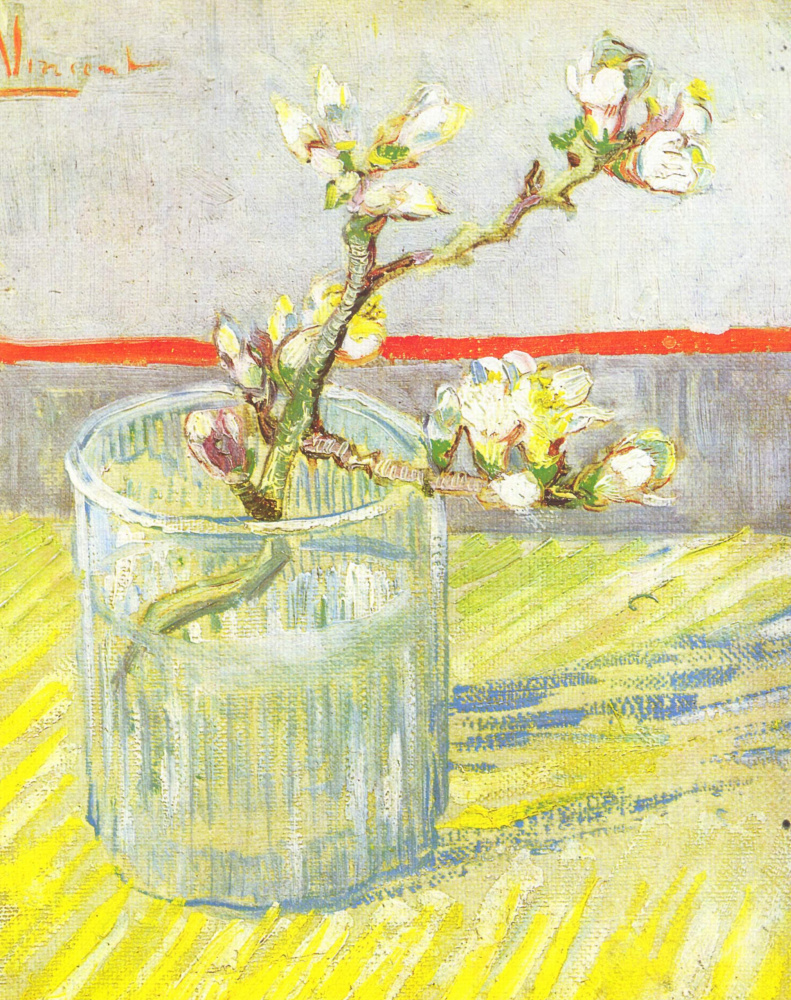log in
Enter site
Login to use Arthive functionality to the maximum
Blossoming Almond Branch in a Glass
Vincent van Gogh • Painting, March 1888, 24×19 cm
Description of the artwork «Blossoming Almond Branch in a Glass»
For two years lived Vincent in Paris with Theo. On 20 February 1886, he came to his brother from Antwerp, and on 20 February 1888, he got off the train in Arles. In fact, Van Gogh was passionate about travelling to the Land of the Rising Sun, because he adored Japanese art, especially painting. But such a trip was just a fantasy for a beggar artist living in the care of his younger brother, so Vincent went to Arles and imagined that he was going to Japan.
When Van Gogh got off the train in Arles and saw that the whole city was covered with snow, he felt much joy. By the way, such weather was an extraordinary rarity for a small southern town. Some people could have lived here all their lives without seeing the snow. But Vincent was lucky: the snowy Arles fit perfectly to his Japanese fantasies. The most amazing thing is that at the same time, trees began to bloom here, first of all, almonds. And again, the artist could not help drawing parallels with Japan, because the bare tree branches, covered with delicate, airy white-pink flowers, looked so much like cherry blossoms.
It is not a surprise that the “Blossoming Almond Branch” painting turned out to be so much Japanese. Vincent used bright, pure colors, flattened the image, drew shadows very conditionally. But at the same time, he used rather rough strokes to create an unmistakable feeling of the warmth of the first spring sun. Over the next few days, Van Gogh would paint 14 more paintings with flowering fruit trees: the snowy landscapes outside the Arles hotel windows, quickly gave way to truly spring ones (1, 2, 3, 4, 5, 6, 7, 8, 9, 10). However, the modest little almond sprig in a rough thick-walled glass would still remain a fascinating in its simplicity symbol of the awakening of nature after hibernation.
Author: Yevheniia Sidelnikova
When Van Gogh got off the train in Arles and saw that the whole city was covered with snow, he felt much joy. By the way, such weather was an extraordinary rarity for a small southern town. Some people could have lived here all their lives without seeing the snow. But Vincent was lucky: the snowy Arles fit perfectly to his Japanese fantasies. The most amazing thing is that at the same time, trees began to bloom here, first of all, almonds. And again, the artist could not help drawing parallels with Japan, because the bare tree branches, covered with delicate, airy white-pink flowers, looked so much like cherry blossoms.
It is not a surprise that the “Blossoming Almond Branch” painting turned out to be so much Japanese. Vincent used bright, pure colors, flattened the image, drew shadows very conditionally. But at the same time, he used rather rough strokes to create an unmistakable feeling of the warmth of the first spring sun. Over the next few days, Van Gogh would paint 14 more paintings with flowering fruit trees: the snowy landscapes outside the Arles hotel windows, quickly gave way to truly spring ones (1, 2, 3, 4, 5, 6, 7, 8, 9, 10). However, the modest little almond sprig in a rough thick-walled glass would still remain a fascinating in its simplicity symbol of the awakening of nature after hibernation.
Author: Yevheniia Sidelnikova







